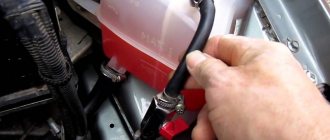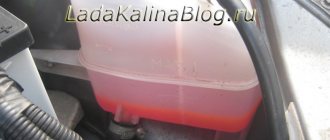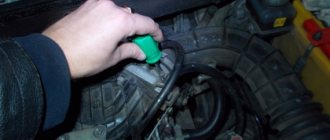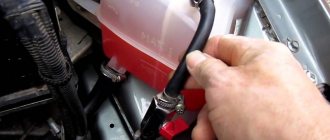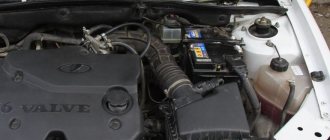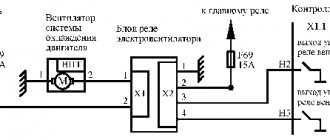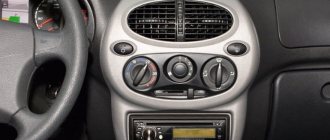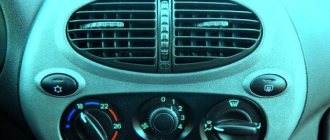A side effect of the operation of an internal combustion engine is heat; it is released due to the combustion of the combustible mixture when interacting with rubbing surfaces. If you do not take measures to remove heat from very hot parts, the entire motor will soon fail. Heat removal in water-cooled motors is carried out using coolant. The circulation pump moves fluid from the cylinder block to the radiator. The thermostat is responsible for quickly warming up to operating temperature; it separates two circuits (small and large). Separating the circuits serves to quickly heat the motor to operating temperature and prevent overheating. To prevent the liquid from boiling, the pump creates pressure in the cooling system. If everything is in order, then during normal operation it is impossible to overheat the power plant even on a summer day. If the temperature gauge needle is in the red zone, you should immediately check all components and mechanisms to avoid failure of the power plant.
Cooling system Lada Kalina
Safe driving of the vehicle depends on the uninterrupted and normal functioning of the Kalina cooling system. If the Lada's cooling system becomes airy, the car begins to overheat. This factor negatively affects the functionality of the motor.
Return
Technical features of the system
Expansion tank
The unified layout and closed design of the engine cooling system (SOD) of the Kalina are also characteristic of other VAZ models. The system is designed to remove thermal energy from heated engine elements using antifreeze or other coolant.
The SOD consists of the following functional parts.
- Cooling radiator. Reduces coolant temperature due to the flow of cold air masses.
- Expansion tank. Designed to compensate for the volume of coolant (coolant). The need for this unit is related to the expansion/constriction property of the coolant.
- A pump or centrifugal pump, which is responsible for the forced circulation of antifreeze through the appropriate channels.
- A thermostat whose task is to regulate the volume of antifreeze in the Kalina cooling system.
- Temperature sensor involved in SOD control.
Fan. Used for rapid cooling of antifreeze in the Kalina cooling system.
The operation of the cooling system is based on the close interconnection of various parts, elements and sensors, including devices that are designed to measure oil temperature. The passage of coolant in a large or small circle depends on the engine temperature. In the first case, antifreeze passes through all components of the SOD, except the radiator.
With such circulation, the thermostat is closed. As the engine temperature rises, this element gradually opens. The antifreeze, having passed a large circle, enters the radiator. The latter device is cooled by oncoming air masses. If this is not enough, a signal is sent to the ventilated unit, which begins to forcibly direct air masses to the cells.
The cooled liquid enters a small circle. Next, taking into account the engine temperature, the antifreeze automatically circulates in a small or large circle. At the same time, the optimal operating temperature is maintained, which should be in the range of 95-105°C. This factor has a direct impact on the performance of the Kalina stove. In this case, it will not be able to supply warm air masses into the cabin.
If there are any doubts about the operation of the ODS, you need to diagnose the car, finding out the causes of the malfunction. You can fix the breakdown either with your own hands or with the help of a car mechanic.
First, it is recommended to check the antifreeze level in the system. To do this, you will need to open the hood and inspect the expansion tank. It should be filled to 1/2 of the total volume. If necessary, antifreeze is topped up or the coolant is completely replaced. In the latter case, you will need to drain the old antifreeze. If there is a fluid leak, you need to inspect the engine compartment.
Return
The main causes of ODS malfunctions
Coolant leakage is mainly due to the following reasons:
- presence of an old clamp;
- old or broken radiator.
In the first case, the unit is replaced, and in the second, repairs are carried out.
First of all, check the system pipes
Then you will need to check the circulation of fluid in the motor system in question. To do this, you need to see if antifreeze is entering the tank. If the result is negative, then replace the pump or clean the cooling system with special means.
If the Lada Kalina overheats, auto mechanics identify the following reasons for this situation.
- The thermostat has failed. To check its functionality, you need to touch the radiator pipes. If the top element is cold and the bottom element is warm, the thermostat is stuck. In this case, a new unit is installed.
- Clogged honeycombs. This problem usually occurs in late spring and early summer. In such a situation, clean the outer part of the radiator.
- Fan malfunction. If this device does not turn on when the coolant temperature is high, you need to check the wiring and relay.
- Presence of air masses in the SOD.
To solve the last problem, you will need to open the expansion tank. Start the engine, periodically press the gas pedal until the red mark is reached on the sensor. If the fan turns on, then you need to “add gas” by turning off the ignition. If it is not possible to eliminate the airlock using this method, more radical measures are used.
The plastic motor screen will need to be removed. To do this, he rises. Use a screwdriver to lower the clamp. Remove 1 of the 2 fitting tubes. Then remove the expansion tank cap. You need to blow into the container until antifreeze begins to pour out of the dismantled tube.
If it is not possible to break through the container, the lid closes. The tube is put in place. The engine warms up and the ignition turns off. Without dismantling the tank lid, remove the heating tube.
Return
Important points of improvement
Refinement of the system
Coolant is considered a toxic substance that adversely affects human health. Auto mechanics recommend draining antifreeze with caution. When carrying out this procedure, you need to remember safety precautions and use rubber gloves. The antifreeze is drained when the engine is cold. Then the tube is put on the fitting, the clamps are tightened. Air masses have been successfully removed from the system under consideration.
Kalina's SOD needs improvement. Its modification involves the installation of a new 6-hole thermostat. This unit will maintain a stable fluid temperature, normalizing the operation of the interior heating devices.
Modification of the cooling system involves installing a coolant filter or a heater tap. To ensure that antifreeze passes through the channels faster and the risk of overheating is minimal, you will need to install an additional pump. You can tune the Kalina SOD yourself using the engine cooling system diagram.
Source: https://expertvaz.ru/lada-kalina/zamena-zhidkosti-sisteme-oxlazhdeniya.html
Thermostat malfunctions
The design of the thermostat consists of a housing with pipes and a sensitive element with a valve, which actually shuts off the pipeline. The housing itself fails extremely rarely, and only due to mechanical damage.
Most often the sensitive element breaks. It is a sealed cylinder filled with a wax-based solid. The cylinder contains a piston with a rod. When heated, the substance melts and expands, pushing the piston. The latter extends and closes the valve.
The most common reasons for thermostat failure are:
- deposits of products of corrosion processes on the moving parts of the sensitive element;
- dirt, scale or foreign objects entering the thermostat housing;
- poor quality coolant;
- malfunction of the water pump (pump).
One symptom of a faulty thermostat is an overheating engine. It indicates that the coolant (coolant) moves in a small circle without passing through the radiator. It can also happen the other way around, when the liquid moves constantly in a large circle. In this case, the engine will take a very long time to warm up.
Improvement of the cooling system of the Lada Kalina car
20.11.2017
A side effect of the operation of an internal combustion engine is heat; it is released due to the combustion of the combustible mixture when interacting with rubbing surfaces. If you do not take measures to remove heat from very hot parts, the entire motor will soon fail.
Heat removal in water-cooled motors is carried out using coolant. The circulation pump moves fluid from the cylinder block to the radiator. The thermostat is responsible for quickly warming up to operating temperature; it separates two circuits (small and large).
Separating the circuits serves to quickly heat the motor to operating temperature and prevent overheating. To prevent the liquid from boiling, the pump creates pressure in the cooling system. If everything is in order, then during normal operation it is impossible to overheat the power plant even on a summer day.
If the temperature gauge needle is in the red zone, you should immediately check all components and mechanisms to avoid failure of the power plant.
Symptoms of problems
There are a number of symptoms that indicate a malfunction of the cooling system; if at least one of them is detected, it is worth taking corrective action.
- When the engine is not started and has cooled down (more than 8 hours of inactivity), a residual pressure remains in the cooling lines (this can be understood when the rubber pipes are pressed, they will be hard).
- The release of coolant when the engine is running can be either a small amount or a significant column of steam.
- Coolant leakage from lines or radiators is accompanied by a decrease in the coolant level in the tank.
- When the engine is fully warmed up, cold air blows from the deflectors coming from the cabin heater. The effect may disappear when the crankshaft speed increases.
And if with the first three points everything is more or less clear, then with the last it’s not so simple. You can change radiators, thermostats and coolant as much as you like, but you still won’t achieve a positive result. The problem is the formation of an air lock that cannot be seen. The air in the lines prevents the normal removal of heat from highly heated parts, which can lead to serious damage to the power plant.
Refinement of the cooling system of the Lada Kalina car
Considering the fact that this problem is not uncommon for Kalina owners, we can assume that this is a miscalculation of Tolyatti engineers. The owner will have to correct this development inaccuracy.
- Drain the coolant.
- We dismantle and install the plug on the wide pipe, which is connected to the bottom of the expansion tank.
- We install a tee in the lower hose of the stove.
- We install a hose of suitable size, which is connected at one end to the tee, and at the other to the bottom of the expansion tank.
- We install a plug in the return line of the throttle valve heating, and in its place we install an additional hose.
- In the upper part of the expansion tank, you need to install an additional fitting, to which you need to attach a pipe for heating the throttle valve. There is also an option that does not require cutting in an additional fitting. To do this, you need to connect the new line to the upper pipe of the expansion tank using a tee.
- Fill the coolant a little above the maximum mark, start the engine and warm it up until the fan turns on.
- We expel air from the system, pushing through all the lines, and, if necessary, add coolant to the level.
This modification option will prevent the formation of an air lock, and if air gets in during scheduled repairs, removing it will not be difficult. After such a modernization, a slight negative effect is possible in the form of a long warm-up of the engine. But the undoubted advantages will be a well-heating stove and the absence of air locks.
Source: https://remam.ru/vozdsys/dorabotka-sistemy-ohlazhdeniya-lada-kalina.html
The cooling system of the Lada Kalina is one of the most important systems of the car. Due to its importance, the ODS should not have malfunctions. If the cooling system becomes airy, the Kalina will simply overheat, and this is a very significant factor affecting the operation and functionality of the internal combustion engine as a whole. However, we will not reveal the topic in advance - we will talk about all the details, malfunctions and ways to improve the SOD in the course of our article today.
Peculiarities
On almost all cars of the VAZ family, including passenger cars of the Kalina model, the cooling system has the same design and operating principle. SOD on the VAZ 2117 refers to closed-type liquid cooling systems. This means that thermal energy is removed from the heated parts of the engine by the flow of coolant, that is, coolant (antifreeze).
The cooling system (VAZ Lada Kalina) includes a number of functional elements:
- Engine cooling radiator. This unit is designed to reduce the temperature of heated antifreeze using a cold air flow.
- Radiator fan. This part performs the function of increasing the intensity of coolant cooling () in the system.
- Heater radiator. This is essentially a source of warm air for the car interior.
- Expansion tank. Since coolant tends to expand and contract with constant temperature fluctuations, this container serves to compensate for the volume of antifreeze in the system.
- Centrifugal pump or “pump”. This element carries out forced circulation of coolant through the channels of the vehicle system.
- Thermostat.
This small, seemingly primitive part, performs a very important function: it regulates the required amount of antifreeze passing through the engine cooling radiator. Thanks to the thermostat, the most optimal temperature regime in the system is ensured. - Coolant temperature sensor. This is one of the control elements of the ODS.
The engine cooling system diagram (Kalina 2117) is shown in the photo below:
The operating algorithm of this system consists in the close interaction of various sensors, parts and elements, including devices that measure oil temperature, outside temperature and many other factors. Taking into account all these points, on the VAZ Kalina the cooling system automatically sets the optimal switching conditions and operating time of all structural elements, thereby ensuring effective engine cooling.
It should also be noted that depending on the temperature, the liquid can pass through a small or large circle. In the first case, the antifreeze passes through all the channels of the system, bypassing the radiator. The thermostat is in the closed position during such circulation.
When the engine temperature increases, this part gradually opens, and the antifreeze begins to “run” in a large circle, getting into the radiator.
The latter is cooled by a counter flow of air, and if the SOD is not enough, it will send a signal to the fan, which will force cold air onto the cells.
After cooling, the coolant flows back to the small circle. Then, depending on the engine temperature, the system automatically circulates antifreeze either in a large or small circle, maintaining the optimal operating temperature of the internal combustion engine (95-105 degrees Celsius).
As we noted earlier, ODS plays an important role in the operation of a car. If this cooling system does not work correctly, the engine will often overheat and the heater will stop supplying warm air flow. Thus, with a faulty ODS, the service life of the engine and many other vulnerable elements in the engine compartment is significantly reduced.
How to diagnose SOD?
We have already found out how the cooling system in the VAZ 2117 Kalina is arranged, now we will talk in more detail about how to find out its possible malfunctions.
Please note that if you doubt the proper operation of the cooling system, you do not have to take the car to a service station and order diagnostics - you can find out the reasons yourself.
So where should you start?
The first thing you need to do is check the antifreeze level in the system. To do this, open the hood and look at the expansion tank. Ideally, it should be filled to ½ of the total volume. If necessary, add coolant to this level.
If you find an antifreeze leak, then inspect the engine compartment of the car - there may be leaks here.
The most common causes of coolant leakage from the system are:
- Old clamps on the pipes.
- An old heating radiator or a broken cooling radiator. In the first case, the situation will only be saved by a complete replacement of the device, but in the second, it is quite possible to get by with repairs (soldering the holes).
The next step is to check the coolant circulation in the engine cooling system. To do this, open the cap of the expansion tank and watch how a stream of antifreeze enters it.
If the result is unsatisfactory, you need to either change the pump or clean the SOD system (this can be done using special cleaning products).
If your car begins to overheat frequently, there may be several reasons for this:
- Thermostat. It is very simple to check its performance: on a warm engine, touch the lower and upper radiator hoses with your hand. If the latter turns out to be cold, and the lower one is barely warm, then, most likely, the thermostat is jammed, and the antifreeze circulates only in a small circle. In this case, the solution to the problem will be to install a new device in the car.
- Clogged radiator honeycombs. This is also one of the common causes of malfunctions in the cooling system. It occurs especially often in late May - early June, when annoying poplar fluff flies along the street. The solution to the problem is to clean the outer part of the radiator. This work often causes difficulties for car enthusiasts, but no other methods have yet been invented to solve clogged honeycombs. Therefore, everything is cleaned by hand.
- Faulty fan. If you notice that when the coolant heating level increases, this part does not turn on, you should check the temperature sensor, wiring and relay.
- Air in the cooling system. "Kalina", like any other car, is not immune to an airlock inside the SOD. And if in all previous cases the problem was solved very quickly, or at least clearly, then here car enthusiasts often have problems. Therefore, in order to fully explain the picture, below we will look at how such breakdowns are eliminated.
As you can see, malfunctions of the Kalina cooling system can be quite different. But in any case, overheating is not the best factor for the engine.
“Lada Kalina” and an airlock: how to remove airlock?
The first step is to open the expansion tank cap. Next, start the engine and, periodically pressing the gas pedal, warm up the engine until the temperature gauge rises to the red scale. After turning on the fan, give it a little more gas and turn off the ignition. If the airlock cannot be eliminated in this way, you will have to move on to more radical measures.
How is this done? First, the plastic engine screen is removed (it can be removed with a simple upward movement). Next, use a screwdriver to loosen the clamp, and remove one of the two tubes from the throttle assembly heating fitting. Then the cap of the expansion tank is unscrewed. Cover the neck of the container with a clean rag.
Next, you need to blow into the expansion tank until coolant flows out of the removed tube. If you are unable to break through the container, close the lid and put back the throttle assembly tube. Next, you need to warm up the engine again and turn off the ignition.
After this, without removing the cap from the tank, remove the heating tube again and wait until antifreeze flows out of it under pressure.
Since this liquid is very toxic and poses a certain danger to humans, experts recommend draining the coolant with extreme caution. Don't forget about safety precautions: at a minimum, you should have a pair of rubber gloves. Also monitor the temperature of the tubes; draining the coolant should only be done when the engine has cooled down.
Now put the tube on the fitting and tighten the clamps. At this stage, the air in the cooling system (Kalina, VAZ) has been successfully removed. As you can see, troubleshooting in the ODS can be done without involving specialists.
In the future, in order to prevent similar malfunctions of the cooling system, the Lada Kalina should be regularly diagnosed for the tightness of all clamps and connections in the system.
How to improve SOD?
At the moment, there are several ways to improve ODS:
- Reworking the cooling system. “Kalina” in this case is equipped with a new 6-hole thermostat. This action will make maintaining the temperature of the antifreeze in the system more stable, and will also normalize the operation of the heating elements of the cabin.
- To reduce cooling system malfunctions, the Lada Kalina is equipped with a coolant filter.
- Installation of the stove faucet.
- Additional pump in the engine cooling system. It will not only prevent you from freezing in your car during winter cold, but will also force antifreeze to circulate faster through the channels, which will significantly reduce the risk of engine overheating.
So, we found out how the cooling system in the VAZ Kalina is designed, what problems can arise with it, and how to fix these problems.
Source: https://fb.ru/article/139510/kalina-sistema-ohlajdeniya-neispravnosti-i-usovershenstvovaniya
Verification methods
There are two ways to determine the functionality of the thermostat. The first method involves checking without dismantling. To do this, you need to start a cold engine, warm it up to operating temperature (about 90 degrees), and touch the lower radiator hose.
A cold lower pipe at this temperature indicates that for some reason the thermostat did not open. If it is hot, the thermostat operates normally.
For a more accurate check, you will need to remove the thermostat cover with the sensitive element. Place it in a metal container with clean cold water and place it on the stove to warm up. When the water temperature reaches 85-90 degrees, the element should operate, pushing the valve stem forward. If this does not happen, the thermostat is faulty.
Engine cooling system Lada Kalina 8 valves
Car owners have long been aware of the need to monitor the condition of the engine cooling system. This also applies to owners of practical Lada Kalina models. Constant monitoring of the performance of all components and components of the motor cooling circuit will allow you to avoid unforeseen problems and breakdowns that tend to occur at the most inopportune moment. Today we will look at what kind of engine cooling system is in this car.
Composition of the cooling system?
In a Lada Kalina with an engine of 8 or 16 valves, this unit consists of a considerable number of components, each of which is endowed with a specific function. The coolant filling volume is 7.84 liters. To be able to independently troubleshoot problems in the cooling system, you will need to study it in detail. The cooling circuit can also help with this.
The engine cooling system of the LADA Kalina car has the following components:
- Expansion tank. This component is connected to the radiator through one pipe, and its second hose serves as a filling vessel for the system. The top of this tank is closed with a lid, which contains a special valve to relieve excess pressure.
- Water pump. The element is made of aluminum, which prevents corrosion. The bearing of the product has a special lubricant designed for the entire service life. The pump housing is equipped with a control hole that allows you to determine antifreeze leaks. When this fact is evident, the pump must be replaced immediately.
- Thermostat. The component is equipped with two valves, which serve to regulate fluid flows depending on the amount of heating of the system. If the engine is cold, the valve blocks access to the radiator. Here the fluid circulates inside a small circle in the cylinder block. When the temperature in the system reaches 85 degrees, the valve opens and the liquid rushes through the radiator, which is also called “in a large circle”.
- Temperature sensor. This element of the on-board control and self-diagnosis system serves to continuously monitor the temperature level in the system. A similar element is mounted close to the thermostat housing.
- Radiator. The part is designed to provide effective cooling of a heated engine. Circulating inside a large circle, the liquid “carries” heat into the radiator tubes, which is removed through the honeycomb by an electric fan. The cooled antifreeze flows through the radiator return pipe into the small circle again, and the cycle repeats again.
- Heater radiator. This is a device similar to the main radiator, but smaller in size. The component serves exclusively for heating the interior space of LADA Kalina.
- Fan. It turns on periodically when there is a need to remove heat from the honeycombs of the main radiator unit. Controlled by a relay at the command of the controller.
As we can see, the structure of the system we are considering is not sophisticated. It is not difficult to learn, but it is useful. This will allow you to independently understand the essence of the malfunctions and quickly eliminate them.
Problems and methods for solving them
There are few actual reasons for failures and deviations in the functioning of the cooling system in LADA Kalina. Liquid leaks are the most common. They can arise from loose clamps on the pipes, through the gasket or seal of the pump, a broken radiator (also in the heating circuit), etc.
Copper radiators used to be subject to repair, but it is unlikely that it will be possible to successfully restore a modern aluminum product. The clamps can be tightened, and if it doesn’t help, they can be replaced, fortunately this is a cheap idea.
The radiator is much more expensive, so replacement may be burdensome, but there is no other way.
How to change the running light bulb on a Grant
Granta gearbox with cable drive
Installation of alarm system on Lada Granta
Sometimes the engine cooling system can become clogged. This will require cleaning followed by a complete fluid replacement.
We will also consider other problems that arise in the cooling circuit of the Lada Kalina.
- Thermostat. An effective diagnostic measure would be to manually touch the pipes connected to the radiator. If the lower radiator hose does not warm up on a warm engine, then we can safely state that the thermostat has failed. The valve stopped opening, preventing the liquid from circulating in a large circle. The only way out is to change the part.
- The radiator honeycombs are clogged. Here you also need to resort to cleaning. In spring and summer, debris clogs the honeycombs, making the radiator ineffective in terms of cooling.
- The fan has failed. The first step is to check the integrity of the wiring and the serviceability of the relay in the Lada Kalina with an 8 or 16 valve engine. Most breakdowns point to these components.
- Airing of the system, the so-called air lock. Often air can get inside the circuit, forming plugs. Airing of the system can often be observed after replacing antifreeze. To combat this phenomenon, open the reservoir cap and raise the engine speed (accelerate). If the traffic jam cannot be removed, we try to raise it in front of the car (as high as possible) and continue to practice with the accelerator. Blowing out the tank until liquid appears from the fitting also helps.
Let's sum it up
If the owner of a Lada Kalina with an 8 or 16 valve engine does not have the confidence to independently correct the defects that have arisen in the cooling system, then the only effective action will be to contact a disinterested professional; a cooling scheme can also help. He will quickly diagnose the system, identify the cause and promptly eliminate it. Independent experiments are undesirable, since ignorance coupled with the desire to eliminate the malfunction can only add damage to the long-suffering cooling system.
Source: https://vaz-lada-granta.com/kalina/motor-i-korobka/sistema-ohlazhdeniya.html
Important points when replacing a thermostat
When replacing the thermostat, eliminate the risk of antifreeze getting onto the sensor connectors and into the air path of the Lada Kalina. To prevent such situations, we recommend wrapping electrical connectors and components in plastic bags. Due to the low cost of the thermostat, a more rational action would be to replace the entire thermostat. It is better to purchase original products, since analogues may not match their fastening characteristics (hole diameters, etc.). This will avoid difficult moments during installation.
Lada Kalina 8-valve engine cooling system: diagram
Many car enthusiasts know that the car is equipped with a cooling system that prevents the engine from overheating. So, Lada Kalina has a standard, closed cooling system, which is no different from other devices of the same nature.
A little theory
The Kalina engine cooling system of 8 valves provides cooling of the power unit. Thus, the operating temperature of the motor is 87-103 degrees Celsius.
If this indicator rises, then the engine may overheat, and accordingly the motorist will face quite unpleasant consequences, such as head deflection or, even worse, water hammer.
The power unit may overheat if one of the cooling elements fails. First, there will be a mild stage, during which the engine will simply boil. But there can also be serious consequences, such as deflection and deformation of the cylinder head. At this stage, the situation can be corrected by ordinary grinding of the surface of the block head.
At the middle stage, engine elements may become deformed. This includes the valve mechanism. Subsequently, the block head will require major repairs, and this will cost the vehicle owner a pretty penny.
The severe stage is when the piston group is destroyed due to strong exposure to heat. But, and this is not the worst thing that can happen, because if the coolant gets into the car’s cylinders, the engine will suffer a water hammer, in which a major overhaul does not always save the day.
Cooling scheme
The cooling scheme of the Lada Kalina 8 valves is quite simple. The entire system consists of several fundamental elements that are interconnected. The Lada Kalina power unit has a cooling system with two circles - small and large. The first is designed to warm up the engine, but the second is to provide cooling.
The Lada Kalina engine cooling system has the following diagram.
Cooling system elements
The Lada Kalina cooling system has the following elements: water pump, thermostat, radiator, electric fan, pipes, expansion tank, water jacket and temperature sensor.
To fully understand the circulation pattern and operation of the cooling elements, it is worth considering them separately.
Radiator
One of the main elements of the cooling system, which provides direct cooling of the liquid that passes through the element. The part is cooled using a counter flow of air and an electric fan, which is located behind the radiator. Lada Kalina is equipped with 3-row radiators, which provide maximum cooling of the liquid.
The malfunction of this element may be due to contamination. Therefore, it is necessary to periodically clean the part. The most common method among motorists is cleaning using automotive chemicals. But, the most effective is to dismantle the radiator and clean it with steam or a special liquid under pressure.
Electric fan
The cooling system fan provides additional cooling of the radiator when there is not enough oncoming air flow. The most common malfunction associated with the fan is the failure of the fuse and coolant temperature sensor.
temperature sensor
This element ensures timely activation of the electric fan. The principle of operation of the sensor is very simple - I analyze the temperature of the coolant, it sends impulses to the electronic control unit, which, after analyzing the data received, decides whether it is necessary to use the electric fan. A malfunction of the meter can lead to overheating and even greater problems associated with deformation of the cylinder head.
Thermostat
One of the most important cooling elements for Lada Kalina and any other car. When the car heats up, the thermostat is closed, allowing coolant to circulate only in a small circle. After the engine has warmed up to 60-70 degrees Celsius, the thermostat opens wide and fluid begins to circulate through the radiator.
The malfunction of this element often leads to big problems, namely, the power unit overheats or does not heat up to the required temperature. Usually, the problem is related to a stuck valve.
Water pump
The water pump circulates the “coolant” throughout the system. If the element is faulty, then the liquid heats up inside the water jacket of the engine without passing through the radiator, which causes severe heating of the engine and destruction of structural elements. Often, it doesn’t come to this, because the pump is running out and the pump is simply leaking. Replacing an element is quite simple with your own hands, which is what most car enthusiasts do.
Expansion tank and plug
The expansion tank serves as a kind of indicator of coolant in the system. So, it has a minimum and maximum mark on it, which indicate that the coolant should be in these aisles. Also, through the expansion tank it squeezes out the “coolant” in case of overheating.
The expansion tank plug is an element of the cooling system through which hot coolant is actually released into the system and pressure is relieved. Also, through this element the cooling system gases are discharged.
Pipes
Cooling system pipes are elements that serve as a connecting link between different structural parts. It is through them that coolant circulates from the engine to the radiator and vice versa. Failure of these elements can lead to fluid leakage, causing the engine to overheat.
Thus, many car enthusiasts install silicone tubes, which withstand temperature changes much better and are not afraid of the cold, unlike standard ones.
Water jacket
The water jacket is an element of the engine and cooling system, which ensures the heat absorption of the engine coolant for subsequent removal and cooling. This system is located in the cylinder head and cylinder block. When carrying out a major overhaul, it is often discovered that this element has become corroded if the vehicle is operated on water.
Conclusion
The Lada Kalina 8 valve cooling system has a fairly simple design and a standard set of components. Thus, a malfunction of one or more elements can lead to negative consequences that will significantly hit the car owner’s pocket.
Source: https://avtodvigateli.com/detali/sistema-oxlazhdeniya-kalina-8-klapanov.html
Checking for correct installation
It is very easy to check the correct installation and operation of the thermostat in the Lada Kalina. Here you will need to warm up the engine and then immediately turn it off. Next, open the hood and feel for the lower pipe that goes from the radiator to the cooling jacket of the engine block. If it is heated, the thermostat opens, and there is no risk of the Lada Kalina engine overheating. When this phenomenon does not occur, the system components require careful diagnosis. Therefore, it would be a good idea to check the functionality of the new thermostat before installation.
Solving the problem of airing the engine cooling system on Lada cars
December 17, 2014 LadaOnline 175 178
Have you noticed that the heater in your car is blowing cold air? There may be several reasons for the problem, but most often this occurs due to the formation of an air lock in the engine cooling system. Next, we will tell you how to remove air from the cooling system of Lada cars (Granta, Kalina, Priora, Largus, Niva, Vesta or XRAY) in several ways.
Let us remind you that AvtoVAZ installs the same type of power units on its models, so the instructions are similar for all Lada cars.
Method No. 1
- Remove the hose from the throttle body heating.
- Open the cap of the expansion tank, cover the neck with a clean rag and blow into the tank.
- When antifreeze starts flowing from the removed tube, quickly put the hose back in place and tighten it with a clamp.
Attention! Coolant is a toxic substance, so we recommend that you use other methods to solve the problem.
Method No. 2
- Warm up the engine until pressure builds up in the engine cooling system.
- Stop the engine and remove the hose from the throttle body heating. We do not open the expansion tank cap.
- As soon as antifreeze runs out of the hose, quickly put it back on and tighten it with a clamp.
Attention! Antifreeze can be very hot, be careful.
Method No. 3
- With the engine cooled down, remove the upper hose from the expansion tank coming from the radiator of the cooling system.
- Fill the reservoir to the maximum with coolant and tighten the cap.
- We place the hose in an empty canister, and put a hose from the air pump (for inflating tires) on the tank nozzle.
- We pump up the pressure in the tank with a pump, and at the same time the antifreeze will pour into the canister.
- We monitor the level of coolant in the expansion tank and add it if necessary.
- After 2-3 additions of liquid, we restore all connections.
If air in the cooling system occurs periodically, then the car’s cooling system is not sealed. Check the connections of all system hoses for leaks, as well as the expansion tank cap.
See also other photo reports on DIY Lada repairs.
Keywords: cooling system Lada Kalina | Lada Kalina stove | cooling system for Lada Priora | stove Lada Priora | cooling system for Lada Granta | stove Lada Granta | cooling system for Lada Vesta | stove Lada Vesta | cooling system for Lada Largus | 4x4 cooling system | cooling system lada xray | stove Lada Largus | stove 4x4 | Lada Xray stove | universal article
9 -1
Found an error? Select it and press Ctrl+Enter..
Thermostat price
The approximate price of a thermostat cover with a sensitive element in our stores is 450 - 700 rubles . When choosing a spare part, it is better to give preference to branded VAZ models. The catalog number of the Lada Kalina thermostat is 1118-1306010.
The cost of replacing this unit ranges from 500-800 rubles.
In order not to overpay for the work, you can replace the thermostat yourself, but before that, do not forget to check it using the method described above with heating water.
Classic lid upgrade method
Upgrading the cover in this embodiment involves removing and disassembling the component. We take out the rubber seal and the internal assembly (a pair of springs with a valve). We use a screwdriver.
Refinement involves trimming two springs. The first of them must be shortened by one turn, and the second by as many as two. We assemble according to a well-known algorithm. After this, we check the functionality of the upgraded node. The valve outlet element will now begin to open when the pressure reaches 1 bar. Previously, this figure was 1.7 bar.
Upon successful completion, the lid can be easily blown through the mouth. This check ensures there is free passage of air in both directions. If the indicated effect is observed, then we can state that the modification is correct. Now the risk of airing the circuit has been reduced many times over.
Spacious interior is one of the undeniable advantages of Granta
Thanks to the larger wheelbase, even a large person can easily get behind the wheel of the car, and the passenger does not have to squeeze into a limited space. Driving in a car is also more comfortable, because the plastic in the cabin does not creak or grumble, and sounds from outside are muffled by high-quality sound insulation.
If we compare what's best about the Grant Priora and the Kalina liftback, the Grant is miles ahead of its teammates in terms of cabin quietness. Otherwise, the liftback interior is not much different from the Kalina, and also has some absolutely identical elements.
As for the trunk, the Granta exceeds all expectations here. The volume of 440 liters, from 355 liters to the Kalina, allows you to transport a large number of things, so a comparison of the Grant liftback and the Kalina station wagon will definitely be in favor of the Grant.
Design elements
The expansion tank of the Lada Kalina car is made of transparent polyethylene. The system in question is sealed due to the presence of inlet and outlet valves. The SOD scheme in Kalina provides for the presence of a coolant pump. The device body is made of aluminum. There is a control hole inside the unit, which can be used to detect fluid leakage if the pump breaks down.
The cooling system consists of 2 circulation circles:
- the liquid moves through the jacket and radiator (large circle);
- the liquid moves only along the jacket (small circle).
The SOD scheme provides for constant circulation of liquid. This does not take into account the position of the thermostat valves. The last device consists of 2 valves that redistribute the flow of coolant. When the engine is cold, the fluid circulates in a small circle.
Management
We bring to your attention detailed instructions for completely replacing the thermostat with a new one. Even if you don’t understand how to replace the thermostat on a viburnum, the video will help clarify the situation.
1. Disconnect the sensor from the air filter housing and remove the air filter. As a rule, it will take no more than ten minutes to dismantle it. This is done correctly like this:
- completely unscrew the 2 screws located on top, as well as the nut located on the side of the engine compartment. We recommend leaving these parts in one place so that later you don’t have to look for them separately on the market;
- remove the connector installed on the recirculation valve (it, in turn, is based on the filter housing);
- lift the valve up, and then, without disconnecting the tubes, move it all to the free side;
- by unplugging the plug from the air sensor, remove the air hose by loosening the clamp;
- Having slightly loosened and turned the air filter housing, it should come out.
3. Take a 8mm socket wrench and a screwdriver. Use it to loosen the clamps , and then remove the four hoses.
A well-pumped system will not allow liquid to spill in large quantities.
4. Take a 12mm wrench and remove the wire by unscrewing the top nut on the thermostat.
5. Now take the key for 13. There is a nut and a stud on the thermostat - you will find the first in the upper part of the housing, the second at the bottom. Try to remove the thermostat by gently loosening it.
Helpful advice: loosen the thermostat carefully, sometimes helping yourself with a screwdriver.
These actions must be performed because during operation, high temperatures literally “solder” the thermostat, causing the housing to stick. Help with a screwdriver will solve this problem.
How to improve SOD?
At the moment, there are several ways to improve ODS:
- Reworking the cooling system. “Kalina” in this case is equipped with a new 6-hole thermostat. This action will make maintaining the temperature of the antifreeze in the system more stable, and will also normalize the operation of the heating elements of the cabin.
- To reduce cooling system malfunctions, the Lada Kalina is equipped with a coolant filter.
- Installation of the stove faucet.
- Additional pump in the engine cooling system. It will not only prevent you from freezing in your car during winter cold, but will also force antifreeze to circulate faster through the channels, which will significantly reduce the risk of engine overheating.
So, we found out how the cooling system in the VAZ Kalina is designed, what problems can arise with it, and how to fix these problems.
| The engine cooling system (ECS) is one of the main systems of a car. Is cold air blowing from the stove or is the engine on the LADA Kalina overheating? Then the inspection should begin with this system. In this article you will find all the information on the operation of the Lada Kalina cooling system. |
Dynamics and handling
There is no data on this, but the 4x2 formula indicates a lack of off-road characteristics. The ground clearance of these cars is quite high: 160 and 180 mm, respectively, so light off-road conditions will not be a problem for them. Unless, of course, after a long stay the wheels don’t get stuck and spin. Security comes with several options. It is also possible to install an alcohol lock, which will prevent the engine from starting if vapors are present. The cars are equipped with standard solutions, including child seat mounts and keyless engine starting. In more expensive trim levels you can find a higher level of alarm than in previous models.
Symptoms of problems
There are a number of symptoms that indicate a malfunction of the cooling system; if at least one of them is detected, it is worth taking corrective action.
- When the engine is not started and has cooled down (more than 8 hours of inactivity), a residual pressure remains in the cooling lines (this can be understood when the rubber pipes are pressed, they will be hard).
- The release of coolant when the engine is running can be either a small amount or a significant column of steam.
- Coolant leakage from lines or radiators is accompanied by a decrease in the coolant level in the tank.
- When the engine is fully warmed up, cold air blows from the deflectors coming from the cabin heater. The effect may disappear when the crankshaft speed increases.
And if with the first three points everything is more or less clear, then with the last it’s not so simple. You can change radiators, thermostats and coolant as much as you like, but you still won’t achieve a positive result. The problem is the formation of an air lock that cannot be seen. The air in the lines prevents the normal removal of heat from highly heated parts, which can lead to serious damage to the power plant.
The technical side of the coin
it is difficult to understand why Kalina did not remain on the market. In terms of their characteristics, they are practically twins to Grant - a 1.6-liter engine from 87 to 106 horsepower, the presence of a mechanical, automatic transmission and even a robotic version. In both cases, the 98-horsepower version was fully automatic, and the robot assistant was only available in the high-end configuration. But there is still a difference. Kalina was offered in an 82-horsepower version with a manual transmission.
With the same stride and almost the same weight, the size also spoke in favor of Kalina. The Granta was 50 centimeters longer, which played a role when choosing a car in congested areas. 10 Kalin presented 8 grants in the same segment. But what the berry definitely loses is in trunk volume. This seemed especially critical for a station wagon or hatchback, which are traditionally used for country and family trips. 520 liters is much better than 355 or 235. Okay? So fuel consumption and ground clearance are also in favor of the first participant. And don’t forget to mention the fast acceleration to hundreds of kilometers per hour – 11 seconds versus 12.2.
